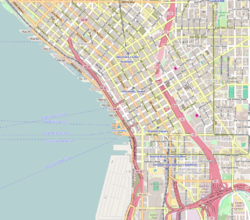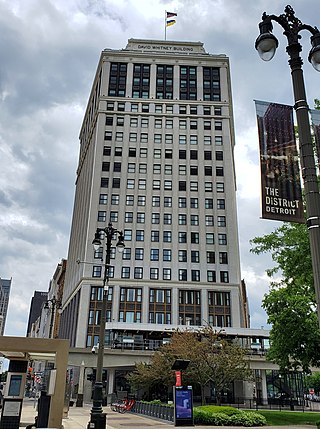
The David Whitney Building is a historic class-A skyscraper located at 1 Park Avenue, on the northern edge of Downtown Detroit, Michigan, within the Grand Circus Park Historic District. The building stands on a wedge-shaped site at the junction of Park Avenue, Woodward Avenue, and Washington Boulevard. Construction on the 19-floor structure began in 1914.
Kirtland Cutter was a 20th-century architect in the Pacific Northwest and California. He was born in East Rockport, Ohio, the great-grandson of Jared Potter Kirtland. He studied painting and illustration at the Art Students League of New York. At the age of 26 he moved to Spokane, Washington, and began working as a banker for his uncle. By the 1920s, Cutter had designed several hundred buildings that established Spokane as a place rivaling Seattle and Portland, Oregon in its architectural quality. Most of Cutter's work is listed in State and National Registers of Historic Places.

Clinton and Russell was a well-known architectural firm founded in 1894 in New York City, United States. The firm was responsible for several New York City buildings, including some in Lower Manhattan.

The Times Square Building, formerly the Times Building, is a registered landmark building in Seattle, Washington. It was completed in 1916 and housed editorial operations of the Seattle Times newspaper, which was housed there until 1930. Located at 414 Olive Way, it is entirely surrounded by streets: 4th Avenue, Olive Way, Stewart Street and 5th Avenue. The building has a Beaux-Arts design and flatiron shape. It is five stories high.
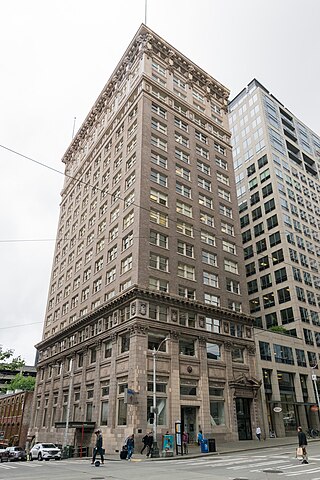
The Hoge Building is a 17-story building constructed in 1911 by, and named for James D. Hoge, a banker and real estate investor, on the northwest corner of Second Avenue and Cherry Street in Seattle, Washington. The building was constructed primarily of tan brick and terracotta built over a steel frame in the architectural style of Second Renaissance Revival with elements of Beaux Arts. It was the tallest building in Seattle from 1911 to 1914, until the completion of Smith Tower.
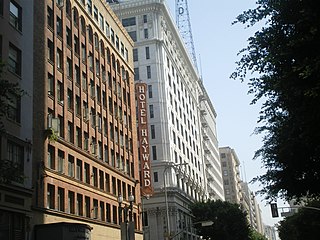
Spring Street in Los Angeles is one of the oldest streets in the city. Along Spring Street in Downtown Los Angeles, from just north of Fourth Street to just south of Seventh Street is the NRHP-listed Spring Street Financial District, nicknamed Wall Street of the West, lined with Beaux Arts buildings and currently experiencing gentrification. This section forms part of the Historic Core district of Downtown, together with portions of Hill, Broadway, Main and Los Angeles streets.

William Lee Stoddart (1868–1940) was an architect who designed urban hotels in the Eastern United States. Although he was born in Tenafly, New Jersey, most of his commissions were in the South. He maintained offices in Atlanta and New York City.

The Bell Apartments, also known as the Austin A. Bell Building is a historic building located at 2324 1st Avenue in the Belltown neighborhood of Seattle Washington. The building was named for Austin Americus Bell, son of one of Seattle's earliest pioneers, but built under the supervision of his wife Eva following Bell's unexpected suicide in 1889 soon after proposing the building. It was designed with a mix of Richardsonian, Gothic and Italianate design elements by notable northwest architect, Elmer Fisher, who designed many of Seattle's commercial buildings following the Great Seattle fire.
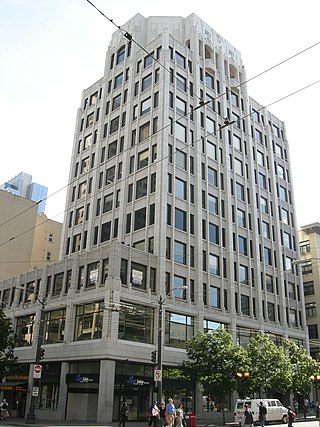
The Olympic Tower, originally known as the United Shopping Tower, then the Northwestern Mutual Insurance Building, and later, the Olympic Savings Tower, is a historic 12-story office tower located in Seattle, Washington and listed on the National Register of Historic Places. It was originally built in 1929 at the Southwest corner of Third Avenue and Pine Street for the United Pacific Corporation under the control of Seattle investment firm Drumheller, Ehrlichman and White. It was designed by Henry Bittman who also designed additions to the building in 1939.

The Holyoke Building is a historic building located in downtown Seattle, Washington. It is a substantial five story brick structure with stone trimmings. Construction began at the corner of First Avenue and Spring Streets just before the Great Seattle fire of 1889. Completed in early 1890, it was among the first permanent buildings completed and ready for occupancy in downtown Seattle following the fire. Today the Holyoke Building is one of the very few such buildings still standing in Seattle outside of the Pioneer Square district and is a historic remnant of the northward expansion of Seattle's business district between the time of the great fire and the Yukon Gold Rush in 1897.

The Globe Building, Beebe Building and the Hotel Cecil are a trio of historic office/hotel buildings located in Downtown Seattle, Washington, United States. The buildings occupy the entire west side of the 1000 block of 1st Avenue between Madison and Spring streets. The three buildings were constructed from late 1900 to 1901 for Syracuse-based investors Clifford Beebe and William Nottingham by the Clise Investment Company, headed by businessman James Clise (1855–1938), as a result of the Alaska Gold Rush which fueled the construction of many such buildings in downtown Seattle.
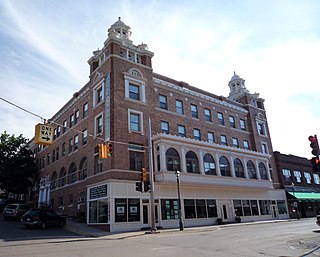
The Douglass House is a hotel located at the corner of Shelden Avenue and Isle Royale Street in Houghton, Michigan. It was placed on the National Register of Historic Places in 1982.

The Diller Hotel is a former hotel building in downtown Seattle, Washington. In the early 1900s, it was known as one of Seattle's few luxury hotels. This historic building is located at the corner of First Avenue and University Street, across from the Seattle Art Museum, and is one of the few remaining buildings left from the 1890s, a period of reconstruction and commercial development after the area was destroyed by the fire of 1889. The hotel was owned by Leonard Diller (1839–1901) and family and was designed by architect Louis L. Mendel. The building is now home to The Diller Room, a craft cocktail bar housed in the former hotel lobby.
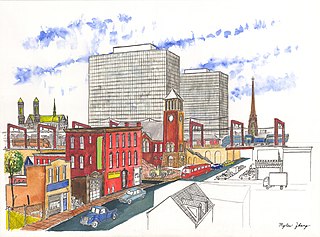
The Pavilion and Colonnade Apartments are three highrise apartment buildings in Newark, New Jersey. The Pavilion Apartments are located at 108-136 Martin Luther King Junior Blvd. and the Colonnade Apartments at 25-51 Clifton Avenue in the overlapping neighborhoods known as Seventh Avenue and Lower Broadway.

The architecture of Seattle, Washington, the largest city in the Pacific Northwest region of the U.S., features elements that predate the arrival of the area's first settlers of European ancestry in the mid-19th century, and has reflected and influenced numerous architectural styles over time. As of the early 21st century, a major construction boom continues to redefine the city's downtown area as well as neighborhoods such as Capitol Hill, Ballard and, perhaps most dramatically, South Lake Union.

The Hull Building is a historic commercial building located at 2401-2405 1st Avenue in the Belltown neighborhood of Seattle, Washington. Designed by notable Northwest architect Elmer Fisher, It was constructed in the latter half of 1889 as an investment property by Seattle politician Alonzo Hull (1843-1929) and was added to the National Register of Historic Places on January 27, 1983. It is adjacent to the Battery Street Tunnel's south portal.

The Colonial Hotel is a historic building in Seattle located at 1119-1123 at the southwest corner of 1st Avenue and Seneca Streets in the city's central business district. The majority of the building recognizable today was constructed in 1901 over a previous building built in 1892-3 that was never completed to its full plans.

Ponce de Leon Apartments is a historic apartment building in Atlanta, Georgia, United States. A part of the Fox Theatre Historic District, the building is located at the intersection of Peachtree Street and Ponce de Leon Avenue in midtown Atlanta. It was built by the George A. Fuller Company in 1913, with William Lee Stoddart as the building's architect. The building was designated a Landmark Building by the government of Atlanta in 1993.

The Rector Hotel, later known as the St. Charles Hotel and during the 1930s the Governor Hotel, is a historic hotel building located at the Southwest corner of Third Avenue and Cherry Street in downtown Seattle, Washington. It was constructed in the latter half of 1911 by the estate of pioneer lumber baron Amos Brown. Designed by prominent Seattle architect John Graham, Sr., the original plans were for a twelve-story building that would be built in two phases but the top 6 floors were never added. Originally a hotel serving the tourist trade, by the 1970s it was operating as a Single resident occupancy hotel. In 1986 it was renovated into low-income housing by the Plymouth Housing Group. In 2002 it was added to the National Register of Historic Places.
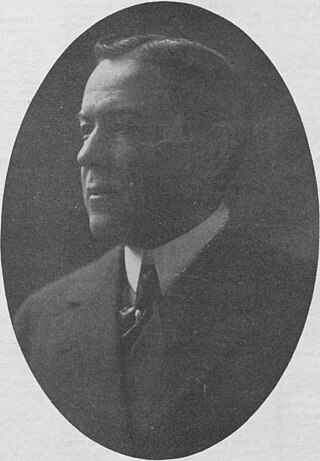
Charles Douglas Stimson (1857–1929) was a prominent businessman in Seattle, Washington.

